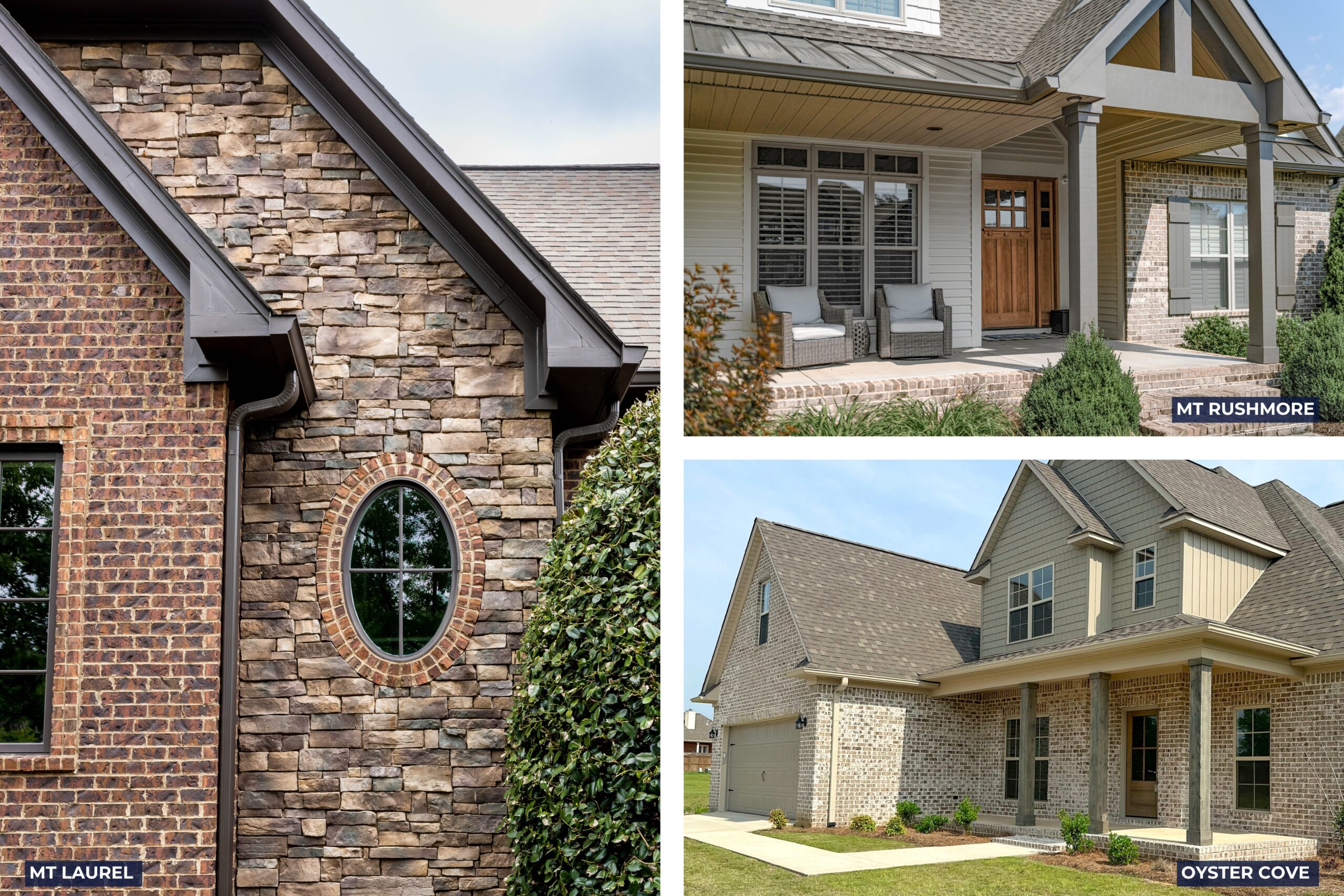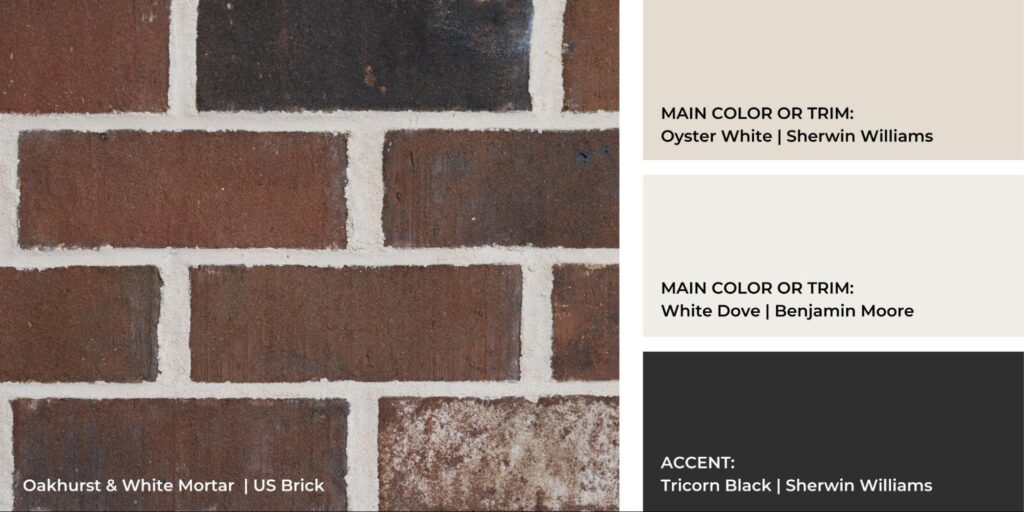Finding the Perfect Brick and Trim Color Combination for Your Exterior
Choosing the right brick can feel as challenging as selecting the perfect shade of white paint, and just when you’ve nailed down the brick, the next dilemma appears: how do you pick the best brick and trim color combination?
Brick generally showcases a range of different colors, all of which can shift with the natural lighting on your lot. The good news is, it’s incredibly versatile and often a pretty forgiving material to work with. To make the process less daunting, we’ve partnered with Sherwin-Williams Design Pros to bring you expert advice on exterior design. In this post, we’ll share best practices and insider tips to help you navigate the delicate dance between brick and paint.If you’re still in the early stages and haven’t yet narrowed down your brick options, be sure to check out our guide to selecting a brick first!
Define Your Style and Color Palette
Before you dive in, Pinpoint your Style! Gather a few inspiration photos (Pinterest is great for this) and look for patterns. Maybe you notice that many of your favorite images feature a single standout detail, like unique shutters or a bold front door against a light neutral background. Recognizing these similarities, whether it’s lighter homes with darker siding or pops of color in an otherwise subtle palette, helps you zero in on the look you love.
No matter your style, in order to create visual harmony you’ll want to stick to a consistent color ratio. A popular approach is the 60/30/10 Rule, in which your dominant color, in this case brick, grounds the design, while secondary and accent hues add interest without overwhelming.
10% Accent Color: Details such as your front door, shutters, and other standout features.
60% Dominant Color: Brick Siding
30% Secondary Color: Elements like window casings, rooflines, and door frames.

Coordinating Brick and Trim Color Combinations
Think of your exterior’s trim as the frame of your home. Emphasize architectural features by using a color that boldly stands out against your brick. Doing this will provide a sharp contrast! For example, with Magnolia brick, a predominantly white brick featuring a brown body (base), sample browns and blacks to create a striking, coordinated contrast. For darker bricks, a crisp white, ivory, or warm neutral trim can deliver a similarly sharp effect.

If you’re aiming for a softer, understated, balanced appearance, consider a harmonious approach. This involves choosing trim colors that are only a few shades lighter or darker than the predominant brick color, allowing for a gentle interplay of color that highlights the trim without overwhelming the brick. For example, with a brick like Oyster Cove, selecting shades of gray or taupe can subtly enhance your siding, or you might experiment with complementary or analogous hues for a nuanced variation.ry mortar provides, but of course there are exceptions.
For example, think about a brick like North Highland. Since this brick has minimal texture and color variation, ivory mortar won’t provide the same contrast as it would with a brick like Avalon or Magnolia. Instead, white mortar would become the choice for achieving a brighter, more cohesive look, and ivory for the a softer, subdued white. Neither option is superior; it simply depends on the look you’re aiming for!
The most foolproof option? Match your trim to your mortar color, for a unified, seamless appearance. Doing this will soften the transition between the brick and trim, creating a visually balanced and cohesive overall appearance. Below are paint swatches from Sherwin-Williams that are color-matched to common mortar colors. If none of these options are a perfect match to your specific shade, take your mortar stick sample to Sherwin-Williams for precise color matching.
Pro-Tip: ALWAYS keep in mind what sand color your mason will be using to mix your mortar!

Column 2: Buff Mortar + Dapper Tan SW 6144, Brown Mortar + Downing Earth SW 2820, Red/Brown Mortar + Tanbark SW 6061
Column 3: Black Mortar + Peppercorn SW 7674, Charcoal Mortar + Westchester Gray SW 2849, Light Gray Mortar Mix + Downing Stone SW 282, Standard Gray Mortar + Acier SW 9170

Column 1: Snowbound SW 7004, Drift of Mist SW 9166, Egret White SW 7570
Column 2: Half-Calf SW 9091, Modern Gray SW 7632
Column 3: Tricorn Black SW 6258, Light French Gray SW 0055, Fleur De Sel SW 7666

Choosing Accent Paint Colors for Your Brick Exterior
Remember, 10% of your exterior palette is reserved for accents, which can include front doors, shutters, lighting fixtures, house numbers, and even garage doors (if they’re meant to stand out). Accent doors, for example, offer a chance to express personality and serve as focal points. A common approach is to select a color that sits directly opposite your brick’s dominant tone on the color wheel; for instance, deep teal or muted green can look stunning with red brick, while navy or rich blue can beautifully complement orange-toned brick.
If you’re leaning toward a more classic look, neutrals like white, black, soft gray, or brown are always a safe bet. Below are several accent paint swatches recommended by Sherwin-Williams Design Pros to help you get started designing the home of your dreams.

Row 2: Roycroft Bronze green SW 2846, Pewter Green SW 6208, Evergreen Fog SW 9130, Silvermist SW 7621, Silver Strand SW 7057
Right Column: Rock Bottom SW 7062, Jogging Path SW 7638, Raisin SW 7630, Sashay Sand SW 6051, Sand Dollar SW 6099
How to Make the Best Brick and Trim Color Combination Decision for Your Home
What looks perfect in a showroom or on a screen can appear entirely different on your home. Always view samples and finishes in the actual lighting conditions of your home’s exterior—morning, noon, and dusk—to capture true color shifts. Oftentimes people will use a site panel for this sampling, which we discuss more in our Brick Selection Process guide.
More Practical Tips & Design Advice for the Home’s Exterior
- Consider your neighborhood, landscape, and surrounding architecture. A color that works in isolation might clash with its environment if not chosen with context in mind.
- Soffits & Fascia often coordinate with the trim color.
- Gutters and Downspouts: For a cohesive look, match to the Trim, Soffits, and Fascia. Want an accent? Consider copper or a metal finish.
- Roof Colors: You can rarely go wrong with a classic slate or black roof, especially when using a cool-toned brick. To add warmth or to complement a warmer-toned brick, consider a brown or weathered wood-toned color roof.
- White or off-white trim is a classic choice that works with nearly any brick color.
- Garage doors typically recede into the background which is why most often people will avoid using an accent or stark contrast here so it doesn’t compete for attention. If you want it to serve as an additional focal point, then disregard this tip!
- Avoid high-gloss finishes unless highlighting a specific detail like the front door.
- Shutters are versatile, meaning they can be used as an accent or play a supporting role. Always opt for a powder-coated finish to prevent corrosion, eliminating maintenance down the line.
- Windows: Dark window frames (black or bronze) are great for adding a modern, masculine, or industrial flair with brick. White frames offer the most traditional look.
- Brick Painting: If painting brick, use a high-quality, breathable masonry paint like ROMABIO to prevent peeling. Fun Fact: US Brick makes painter bricks specifically crafted for painting, available in both smooth or textured finishes.
Finding the right brick and siding color combination is all about balance, style, and thoughtful coordination. With help from Sherwin Williams Design Pros, you can create a timeless and cohesive look that enhances your home’s exterior and overall curb appeal. By considering factors like trim contrast, accent colors, and your home’s natural surroundings, selecting the perfect paint colors will bring out the best in your brick home’s architecture.
Get inspired by exploring our premium selection of brick options and expert resources. Then find a place to connect with one of our experts and start bringing your vision to life!




























